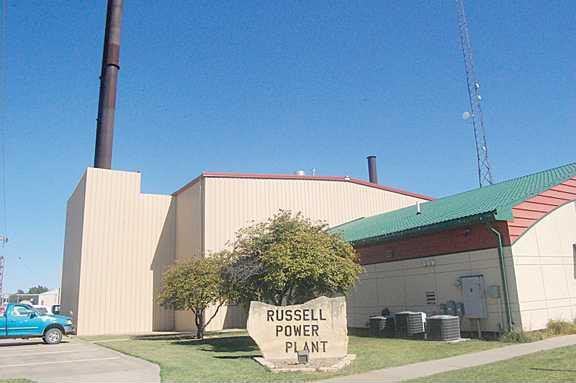The City of Russell celebrated the 100th anniversary of its electric department last month. To mark the occasion, the city will host an open house from 1-3 p.m. Sunday at the plant, 133 West Eighth.
In 1910, the city established a municipal waterworks and electric light plant. For the past century, both municipal utilities in Russell have provided safe, reliable and competitive utility services and have a strong history of innovation and achievement.
While the origins of the City of Russell Electric Department date back to a resolution presented to the city council in 1909, the utility did not begin operation until 1910. It was in October of that year that contracts for the waterworks and electric light plant were signed for a total amount of $79,464. Just over $10,000 of that amount was allocated for a 125 horsepower De La Vergne Machine Company oil engine. In December 1910, the Russell City Council hired D.L. Stromquist as the first superintendent of the city waterworks and electric light plant at a salary of $90 per month. Several assistant engineers were not hired until 1911 and 1913 as well as a city electrician whose job it was to install wiring and fixtures in local homes that desired electric service. Several years later in 1917, new light plant superintendent J.H. Bradley requested and was granted approval by the council to shut down the power plant on Sunday afternoons during clear weather. Mr. Bradley noted that not enough power was being used during this time frame to justify running the engines.
Over the next decade, the electric utility continued to expand and grow. In 1924, Russell signed a contract with the United Power and Light Corporation of Kansas (which was later renamed the Central Kansas Light and Power Company) to provide municipal electric service to their private utility customers outside of city limits. Twelve months later, the company attempted to purchase Russell’s power plant and electric utility for $76,500. The existing city council was agreeable to the purchase, passing Ordinance 368 allowing for the sale. A special city election on October 27, 1925, however, reversed the sale of the system as the citizens of Russell declared their intent to keep the municipal utility. Four years later, Central Kansas Light and Power Company once again attempted to purchase the Russell electric utility, this time at a price of $120,000. Instead, the Russell city council opted to issue $35,000 in electric bonds to expand the municipal power plant with a new 550-horsepower engine.
The electric utility quietly grew over the coming decades, particularly as the city expanded in the 1930s due to a boom in the oil industry. Perhaps the biggest obstacle to the electric utility’s future would not occur until the turn of the next century.
On August 23, 2000, things changed considerably for Russell electric customers. Late that evening, an apparent natural gas leak in the basement of the city’s main power plant was ignited when an employee turned off an electrical switch. The result was a massive explosion and fire that destroyed most of the facility. Power was off to the entire city for several hours while distribution crews rewired and bypassed the plant to renew service to the entire city. Five of the generating units were totally destroyed. Three units suffered some damage but were repaired and remain in service today. The decision to rebuild was made. However, the rebuilding efforts would include not only repairing the existing power plant. A new power plant that would house two solar turbine units that could run on natural gas or diesel fuel was also constructed. Exhaust from the units could be used to make steam that was then sold to nearby industrial customers. The turbines are radio controlled from the operators’ office at the Elm Street plant.
In 2010, Russell’s electric production department now maintains three different locations - three dual fuel units at the Elm Street plant, two diesel units at the Front Street plant and two gas-fired turbines at the 15th Street plant.





